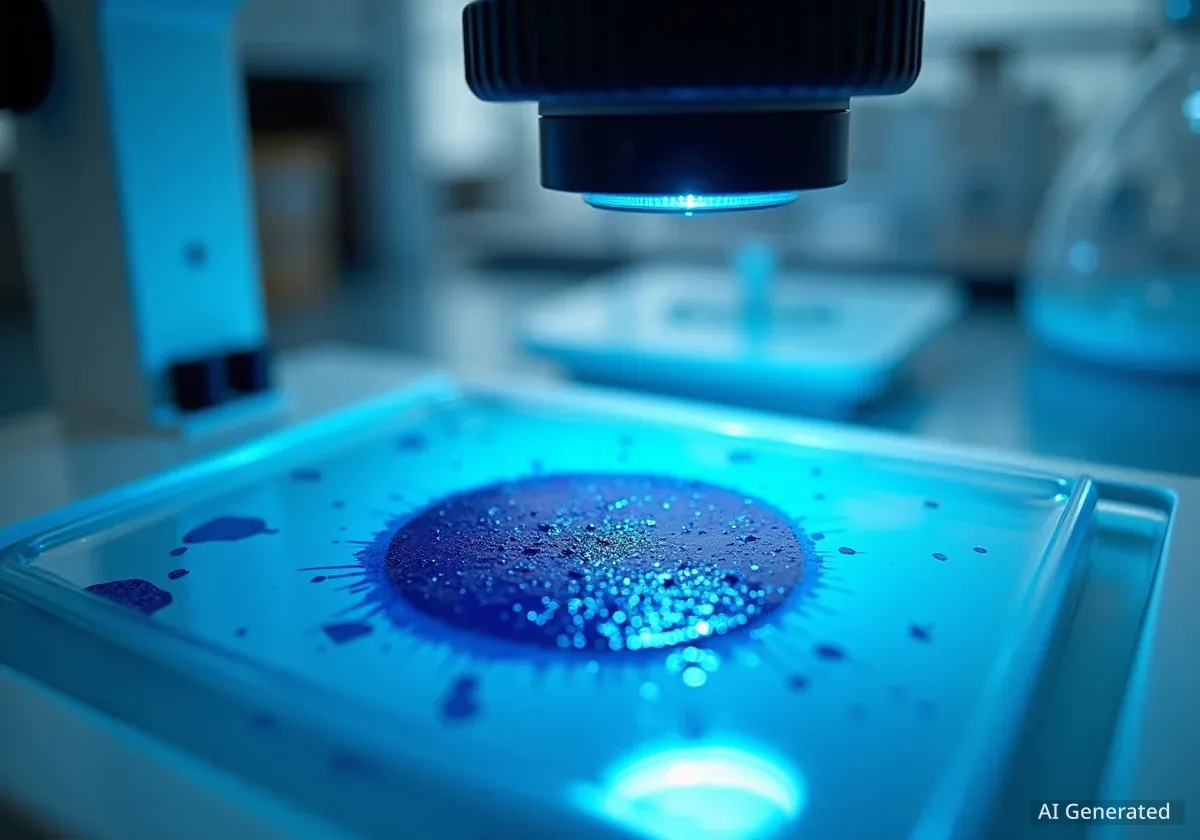Scientists have identified a rare blue pigment in Jackson Pollock's iconic 1948 painting, "Number 1A." This discovery marks the first confirmed use of manganese blue by the abstract expressionist painter. The pigment, now discontinued due to environmental and health concerns, was identified through advanced laser spectroscopy techniques.
Key Takeaways
- Jackson Pollock's "Number 1A, 1948" contains manganese blue pigment.
- This is the first confirmed use of manganese blue by Pollock.
- Manganese blue was discontinued in the 1990s due to health and environmental reasons.
- Identifying pigments helps art conservators preserve artworks effectively.
Unraveling a Pigment Mystery
For decades, the exact chemical origin of the vibrant blue pigment in Pollock's "Number 1A, 1948" remained unknown. Art conservators and scientists have long studied the materials used by famous artists to better understand their work and ensure its longevity. The blue hue, a prominent feature in the painting's layered composition, posed a particular challenge until recently.
Researchers employed laser spectroscopy, a scientific method that examines materials at an atomic level, to analyze the paint samples. This advanced technique allowed them to pinpoint the specific chemical compound responsible for the blue color. The findings were detailed in a study published in the journal PNAS.
Interesting Fact
Manganese blue, chemically known as barium manganate (VI) sulfate, was first discovered in 1907 and patented in 1935. It was widely used by artists for its unique turquoise-blue shade.
The Significance of Manganese Blue
Manganese blue is a distinctive pigment with a turquoise-like appearance. It gained popularity among artists after its introduction but was eventually phased out. By the 1990s, concerns regarding its environmental impact and potential health risks led to its discontinuation.
Abed Haddad, an assistant conservation scientist at the Museum of Modern Art (MoMA) and a co-author of the study, explained that while the pigment itself is no longer produced, similar hues can still be created. Artists can mix different blue and yellow pigments to achieve a color visually similar to manganese blue. However, the chemical composition of these mixed colors would be different from the original pigment.
"Number 1A, 1948 by Jackson Pollock is a quintessential example of his action painting technique where ropes of color, drips of black, and pools of white coalesce into the layered dynamism that defines his style," the researchers wrote in their paper. "While past work has identified the red and yellow pigments that form part of his core palette, the vibrant blue in the painting has remained unassigned."
The Chemistry of Color and Conservation
The research team, including Haddad and Edward Solomon, a chemist from Stanford University, also delved into the chemical properties that give manganese blue its unique color. Solomon explained that manganese blue molecules contain a manganese ion surrounded by four oxide ions. The distinctive blue color emerges when light causes an electron to move from an oxide ion to a manganese ion, absorbing light in the purple and green regions of the spectrum and reflecting blue light.
Understanding the precise chemical makeup of pigments is critical for art conservation. This knowledge extends beyond simple curiosity. It provides practical information essential for preserving valuable artworks. According to Haddad, knowing the exact pigment helps conservators develop effective display strategies.
Background Information
Jackson Pollock (1912–1956) was a leading figure in the abstract expressionist movement. He is famous for his "drip and splash" technique, also known as "action painting," where he poured and splattered paint onto canvases laid on the floor. This method created dynamic, layered compositions that defined his unique style.
Protecting Art for the Future
Many pigments are sensitive to environmental factors. Intense light, ultraviolet radiation, and fluctuations in humidity can cause pigments to degrade over time. Identifying the specific pigments used in a painting allows conservators to implement appropriate measures to protect the artwork from these damaging elements. For instance, certain light filters or humidity controls might be necessary for specific pigments.
Furthermore, pigment identification guides treatment options. Some chemical conditions or cleaning agents might react negatively with particular pigments, potentially causing irreversible damage. By knowing the pigment's chemistry, conservators can select safe and effective treatment methods, ensuring the artwork's integrity for future generations.
This detailed understanding of an artwork's materials is a cornerstone of modern art conservation. It underscores the importance of interdisciplinary research, combining art history, chemistry, and physics, to safeguard cultural heritage. The study's authors also encouraged contemporary artists to document the pigments they use. Such records would greatly assist future conservators in their efforts to preserve art.
- Environmental Factors: Pigments can be damaged by light, UV radiation, and humidity.
- Treatment Options: Chemical identification prevents adverse reactions during conservation.
- Artist Records: Documenting pigments helps future preservation efforts significantly.
The discovery of manganese blue in Pollock's work not only adds to our understanding of his artistic process but also highlights the ongoing efforts to apply scientific rigor to art preservation. This research ensures that masterpieces like "Number 1A, 1948" can be appreciated for many years to come, with their original colors and compositions maintained as accurately as possible.




